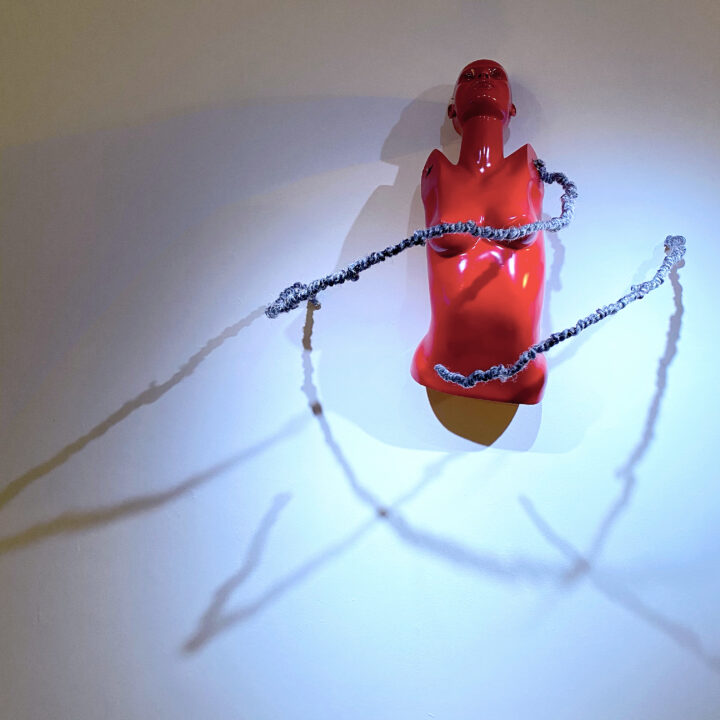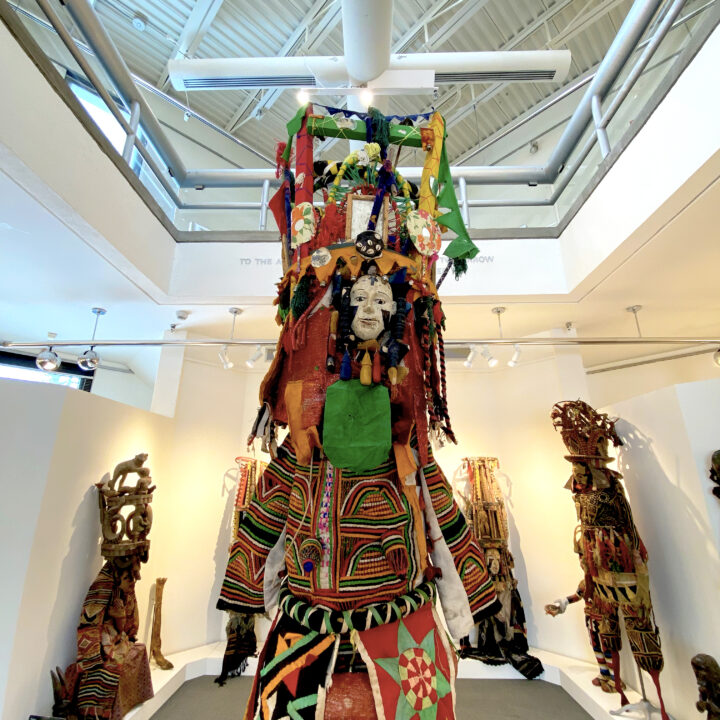Speculative Histories & Material Culture
March 19, 2021 - June 13, 2021
Portland Campus Art Gallery
Featuring historical African masks from the collection of Oscar Mokeme in juxtaposition with site-specific installation by Asata Radcliffe. Radcliffe is an artist, writer, and filmmaker with a focus on participatory, history-based installations which emphasize science fiction, and a speculative approach to the African diasporic and Indigenous experience. Her installation (created in collaboration with other Maine BIPOC artists) revolves around the idea of a speculative future of Maine in the year 2221, from the Indigenous and African diasporic perspective. The fictionalized core of Radcliffe’s work revolves around very real narratives, forming a counterpoint to Mokeme’s masks, which present a specifically embodied history related to the African diaspora and original homeland. Sponsored in part by the Onion Foundation.
March 19–June 13, 2021 at the University of New England Gallery, Portland Campus, 716 Stevens Avenue, Portland, Maine. Open to the UNE community by appointment, and to the wider community remotely. Please contact Hilary at hirons@une.edu
KAL: 2221
Asata Radcliffe
Nmuo, Spirits: African Art as Communication Tool
Historical African Masks From the Collection of Oscar Mokeme
About this Exhibit
The original projection for this installation was to, in some way, project a 200-year cultural future of Maine. The first glimmerings of this vision began as a more concrete visualization, an attempt to project a 200-year future onto mundane cultural objects that function in the 21st century, imagining how those objects might function in a 23rd century. Though this vision did consider the impact of Earth changes, what it didn’t acknowledge were other possibilities of a more human-discursive future, like the continuation of the crusade of Manifest Destiny whose origin story has led to an accelerated planetary climate change; a change which, according to future-map projections, ultimately leaves Maine completely underwater in the year 2221. Though it can be fruitful to create a silver lining future in art, the denial of the impact of current ecological realities would undermine a more honest envisioning of a 200-year projection of Maine or Wabanaki territory.
In this post-human vision, the artists within this installation-collaboration act as time travelers, projecting from the year 2221. This vision encapsulates the Hindi word KAL, a concept of time that is both yesterday and tomorrow. This vision also imprints the legacies of Indigenous, African, Hindi, and Queer futures. As western scientists continue to focus on creating physical machines as transports into the future, artists can time travel utilizing the cosmologies of dream vision, proving that time travel has always been within us.
—Asata Radcliffe, 2021
Artists:
Asata Radcliffe (installation/concept/curatorial, KAL: 221)
Firefly (film, Digital Triptych)
Ian Trask (house piece, Oasis)
Meeta Mastani (flag in stairwell, Kal)
Devon Kelley-Yurdin (sculptural piece in stairwell, Holobiont Waiting Room)
About this Exhibit
From the Igbo of Nigeria, the word “Nmuo” means “Spirit”, and the Igbo believe that sacred objects embody spirit beings effective in rituals. The power of these rituals is reflected in the beauty, symbolism, and spirituality of this collection. Representing over 15,000 years of Igbo and African traditions, the masks are from a private collection of over 5,000 masks celebrating the Igbo spirit mask and ritual implements of Oba-Idemili and its surrounding area, a region in the Igbo ethnic group of southeastern Nigeria.
“Nmuo, Spirits” highlights the mask as both ritualistic and communication figure, and ultimately aims to enhance knowledge of the central roles African masks can play in multi-cultural understanding. Each mask is a communication figure that projects significant cultural voices; reflects the construction of social hierarchies; actively links peoples and cultures; and demonstrates the interactions between masks and other art forms.
The masks illustrate the power of retaining ancestral culture in a modern world and provide insight into the cultural history, customs, and belief-systems of the Igbos and other African cultures. The inherent magic of ritual and communication projected by this collection speaks to all audiences on a universal level.
—Oscar Mokeme, Director, The Museum of African Art & Culture



